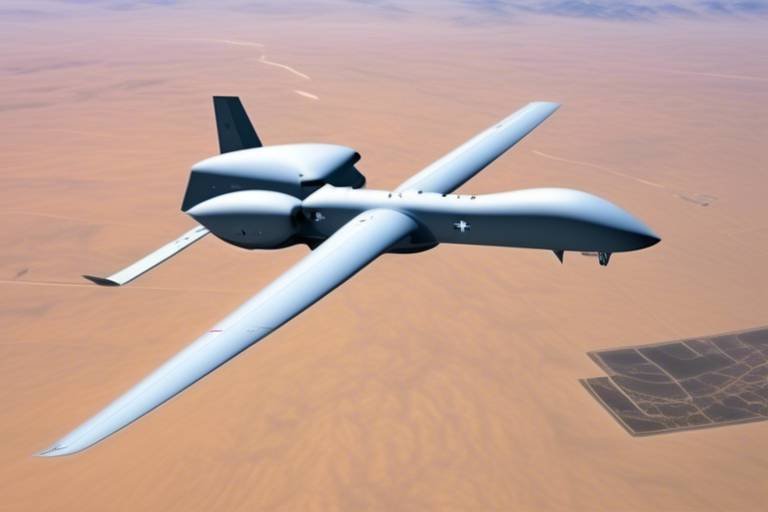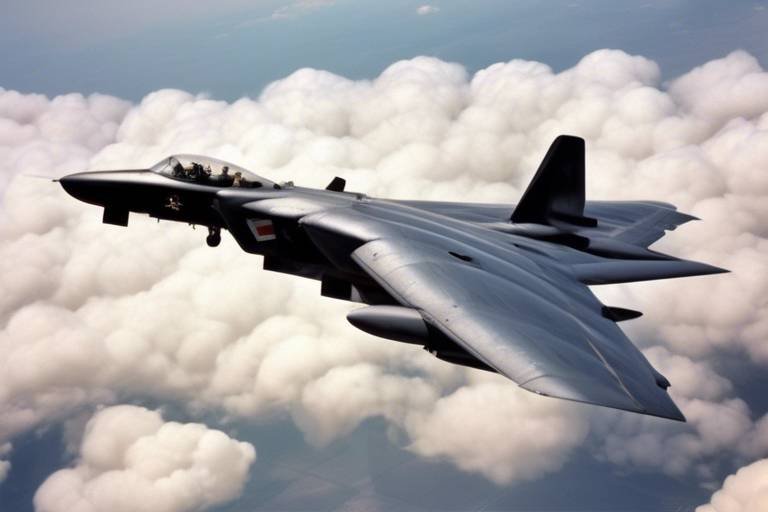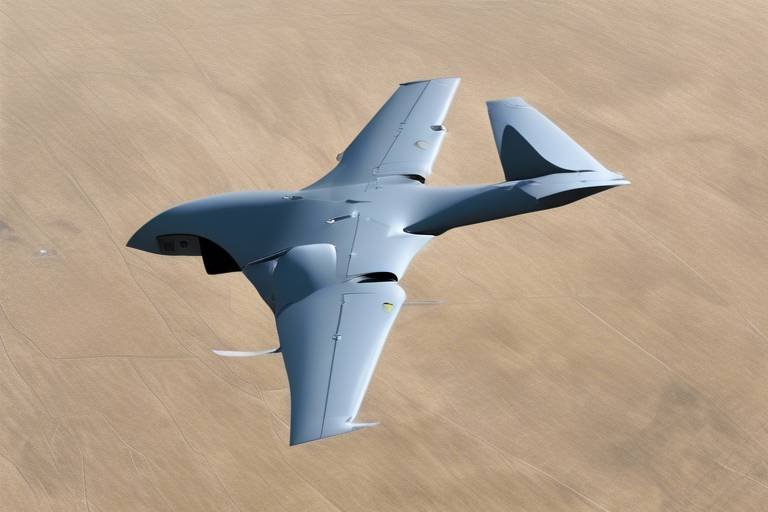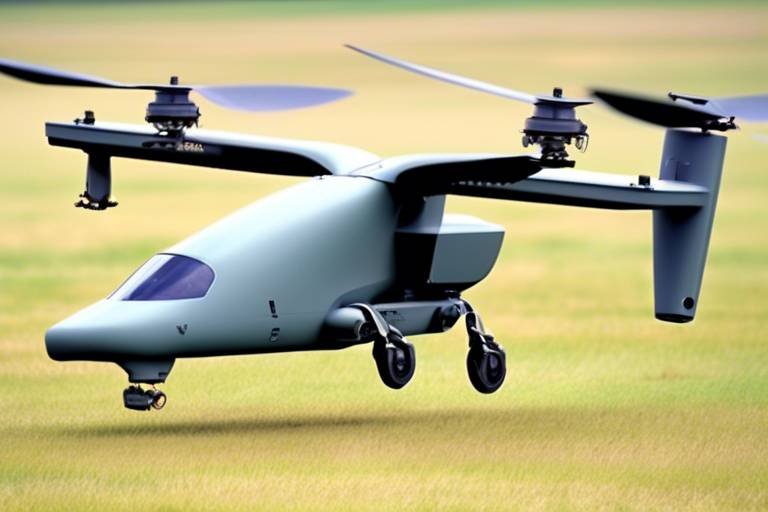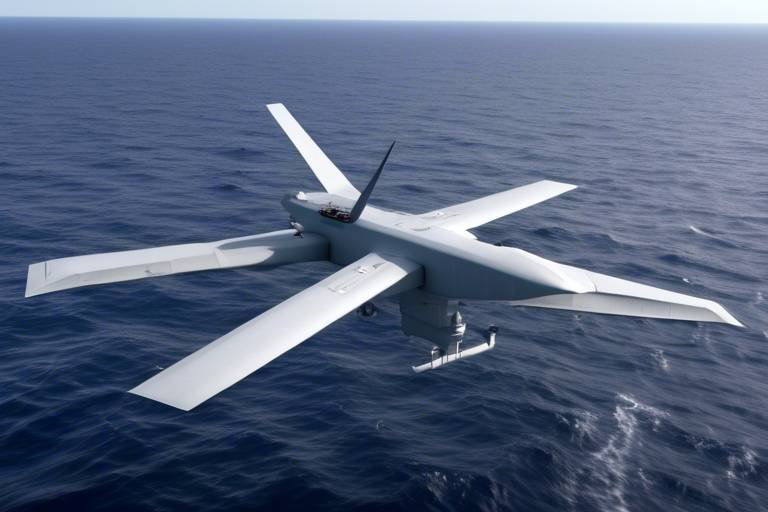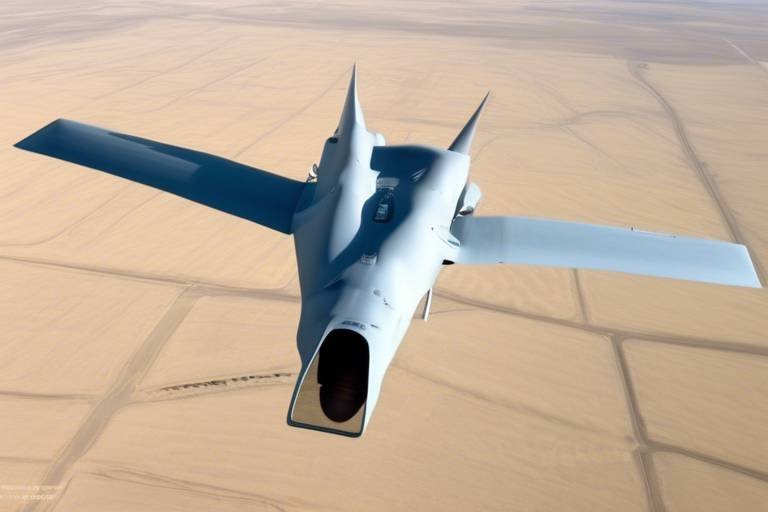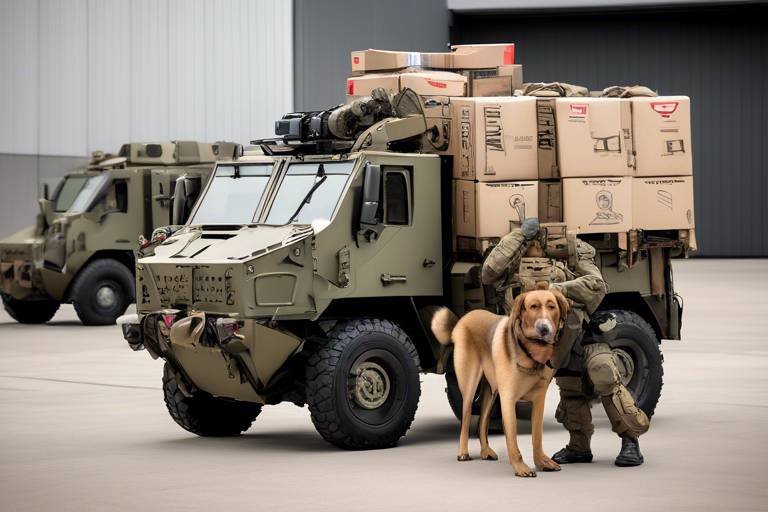Current Trends in the Development of Military Robotics
The landscape of military operations is undergoing a dramatic transformation, driven by the rapid advancements in military robotics. As nations strive to enhance their defense capabilities, the integration of cutting-edge technologies is reshaping how wars are fought and won. From autonomous systems to the incorporation of artificial intelligence, these innovations are not only improving operational efficiency but also redefining the very essence of combat. Imagine a battlefield where robots and humans work in tandem, each playing a vital role in a complex dance of strategy and execution. This is not science fiction; this is the reality of modern warfare.
At the heart of this revolution lies the development of autonomous military robots. These machines are designed to operate without direct human control, allowing for unmanned operations that significantly reduce the risks to human life. Picture a scenario where drones can conduct reconnaissance missions or carry out strikes with pinpoint accuracy, all while keeping soldiers safely away from the front lines. This shift towards autonomy is not just about safety; it's about enhancing the efficiency of military operations, enabling forces to respond more quickly and effectively to emerging threats.
Moreover, the integration of artificial intelligence into military robotics is a game-changer. AI empowers these machines to make smarter decisions, improving their ability to identify targets and assess complex situations in real time. For instance, advanced algorithms can analyze vast amounts of data to determine the best course of action in a split second. This capability is particularly crucial in high-stakes environments where every second counts. By leveraging AI, military robots can adapt to their surroundings, learning from previous encounters to enhance their operational capabilities.
Delving deeper, we find that machine learning is at the forefront of this technological evolution. Military robots equipped with machine learning algorithms can analyze data from various sources, allowing them to adapt and improve their performance over time. For example, a robot tasked with surveillance can learn to distinguish between friend and foe by processing countless images and scenarios, making it an invaluable asset in the field.
Another exciting application of AI in military robotics is predictive maintenance. This technology enables military forces to anticipate potential failures in their robotic systems, ensuring that they remain operational when it matters most. By monitoring the performance of various components and analyzing patterns, predictive maintenance can significantly reduce downtime and enhance mission readiness. Imagine a robot that can self-diagnose issues before they escalate, much like a car that alerts you to a potential problem before it breaks down.
Additionally, AI-driven combat simulation training is revolutionizing how military personnel prepare for real-world scenarios. These simulations allow soldiers to interact with robotic systems in a controlled environment, honing their skills without the risks associated with live training exercises. This not only enhances their preparedness but also fosters a deeper understanding of how to effectively collaborate with robots in actual combat situations.
As military robotics continue to evolve, the collaboration between soldiers and robots is becoming increasingly seamless. Rather than replacing human operators, these systems are designed to assist them, enhancing their capabilities and providing critical support during operations. Imagine a soldier equipped with a robotic exoskeleton that amplifies their strength and endurance, allowing them to carry heavy loads over long distances. This synergy between humans and robots is not just a trend; it's the future of military operations.
However, with great power comes great responsibility. The development of military robotics raises significant ethical questions about autonomy, accountability, and the implications of using robots in armed conflict. As we embrace these technologies, we must also consider the moral ramifications of their deployment. Are we prepared to hand over critical decisions to machines? What happens if a robotic system malfunctions during a mission?
Establishing clear rules of engagement for robotic systems is crucial to ensure compliance with international humanitarian law. These guidelines will help maintain accountability in military operations, ensuring that the use of robots does not undermine ethical standards. The conversation around these rules is ongoing, and it is essential that all stakeholders, including governments, military leaders, and the public, participate in shaping the future of military robotics.
Understanding public perception of military robotics is equally important. The acceptance of these technologies within society can influence policy decisions and funding for research and development. As we move forward, fostering an open dialogue about the benefits and challenges of military robotics will be vital in ensuring that these advancements are embraced rather than feared.
- What are military robots used for?
Military robots are utilized for reconnaissance, surveillance, logistics, and even combat operations, enhancing the effectiveness and safety of military missions. - How does AI improve military robotics?
AI enhances military robotics by enabling smarter decision-making, better target identification, and the ability to adapt to complex environments. - What are the ethical concerns surrounding military robotics?
The main ethical concerns include autonomy in decision-making, accountability for actions taken by robots, and compliance with international laws. - How can the public influence military robotics policy?
The public can influence policy through advocacy, education, and participation in discussions about the implications of military technology.
Autonomous Systems
This article explores the latest advancements in military robotics, highlighting innovations, applications, and ethical considerations shaping the future of defense technology.
Autonomous military robots are not just a futuristic concept; they are revolutionizing combat strategies right now! Imagine a battlefield where machines can operate without constant human intervention, drastically enhancing efficiency and minimizing risks to human life. These robots are designed to perform a variety of tasks, from surveillance to logistics, and even direct combat roles. By leveraging advanced technologies, they allow military forces to maintain a strategic edge over adversaries.
One of the most significant advantages of autonomous systems is their ability to reduce human risk in hostile environments. Soldiers can remain at a safe distance while robots carry out dangerous missions. This capability not only saves lives but also allows for more strategic planning, as operations can be executed without the immediate threat to personnel. The potential applications of these systems are vast:
- Surveillance and Reconnaissance: Autonomous drones can gather intelligence without putting soldiers in harm's way.
- Logistics Support: Unmanned ground vehicles can transport supplies to troops in challenging terrains.
- Combat Operations: Robots can engage in direct combat, executing missions that would be too dangerous for humans.
Moreover, these systems are equipped with sophisticated sensors and communication technologies that enable them to operate in complex environments. They can analyze their surroundings in real-time, making decisions based on the data they collect. This level of autonomy is not just about acting independently; it’s about making informed decisions that can significantly impact the outcome of military operations.
However, the rise of autonomous systems does not come without challenges. As these robots become more integrated into military operations, questions arise about command and control. Who is responsible if an autonomous robot makes a mistake? These ethical dilemmas are crucial to address as we move forward in developing and deploying these technologies.
In conclusion, autonomous military systems are paving the way for a new era in defense technology. Their ability to operate independently, reduce risk to human life, and enhance operational efficiency makes them an invaluable asset on the battlefield. As we continue to innovate and refine these systems, it is essential to keep the ethical implications in mind, ensuring that we use these powerful tools responsibly.
- What are autonomous military robots?
Autonomous military robots are unmanned systems designed to perform tasks without direct human control, utilizing advanced technologies for decision-making and operation.
- How do autonomous systems enhance military operations?
They enhance military operations by performing dangerous tasks, reducing human risk, and improving efficiency through real-time data analysis and decision-making.
- What are the ethical concerns associated with military robotics?
Ethical concerns include accountability for actions taken by autonomous systems, adherence to international humanitarian law, and the potential for misuse in armed conflicts.
Artificial Intelligence Integration
Artificial Intelligence (AI) is at the forefront of the revolution in military robotics, fundamentally transforming how armed forces operate. Imagine a battlefield where machines can analyze data faster than any human could, making decisions in real-time to enhance mission success. This is not science fiction; it’s the reality we are stepping into. The integration of AI into military robotics is enabling smarter decision-making, improving target identification, and enhancing operational capabilities in complex environments.
One of the most impressive aspects of AI integration is its ability to process vast amounts of data. Traditional military operations often rely on human analysts to sift through information, which can be time-consuming and prone to error. However, with AI, military robots can autonomously gather and analyze data from various sources, including satellite imagery, reconnaissance drones, and battlefield sensors. This capability not only speeds up the decision-making process but also increases accuracy, allowing military personnel to make informed choices based on real-time insights.
Moreover, the use of AI in military robotics is expanding into various applications, such as:
- Target Identification: AI algorithms can quickly distinguish between friend and foe, reducing the risk of friendly fire and increasing operational efficiency.
- Surveillance: Autonomous drones equipped with AI can monitor vast areas, detecting unusual activities and alerting ground forces to potential threats.
- Logistics Management: AI systems can optimize supply chains, ensuring that troops receive necessary supplies at the right time and place, thus maintaining operational momentum.
Furthermore, AI is not just about enhancing existing capabilities; it's also about creating new ones. For instance, the development of machine learning applications allows military robots to adapt and learn from their environments. This means that as a robot encounters different scenarios, it can adjust its algorithms to improve performance in future missions. This adaptability is akin to a soldier learning from each engagement, becoming more effective over time.
Machine learning is a subset of AI that focuses on the development of algorithms that allow computers to learn from and make predictions based on data. In military robotics, this technology is crucial. For example, consider a surveillance drone that uses machine learning to recognize patterns in enemy movements. Initially, it might struggle to identify specific behaviors, but as it collects more data, it becomes proficient at predicting when and where an attack might occur. This capability can be a game-changer in preemptive defense strategies.
Another significant advantage of AI integration is predictive maintenance. Military robots, like any other machinery, require maintenance to operate effectively. Traditional maintenance schedules can lead to unnecessary downtime or, worse, failures during critical missions. AI can analyze performance data in real-time, identifying potential issues before they become serious problems. This proactive approach ensures that military robots are always ready for action, significantly enhancing operational readiness.
AI-driven combat simulation training is also revolutionizing how military personnel prepare for real-world scenarios. By creating realistic environments where soldiers can interact with robotic systems, training becomes more immersive and effective. Imagine a soldier practicing in a simulated urban environment, facing off against AI-controlled robots that mimic enemy tactics. This kind of training not only builds confidence but also enhances teamwork between human operators and robotic systems, preparing them for seamless collaboration in actual combat situations.
As we move forward, the integration of AI into military robotics promises to redefine modern warfare. The potential for enhanced decision-making, improved operational capabilities, and increased safety for personnel is immense. However, it also raises important questions about the future of warfare and the role of humans in an increasingly automated battlefield.
- What are the main benefits of AI integration in military robotics? AI enhances decision-making speed, improves target identification, and allows for autonomous operations, significantly increasing operational efficiency.
- How does machine learning improve military robots? Machine learning enables robots to adapt and learn from their environments, improving their performance over time based on experience.
- What is predictive maintenance in military robotics? Predictive maintenance uses AI to anticipate potential failures in robots, ensuring they remain operational and ready for missions.
- How does AI-driven combat simulation training work? It creates realistic training scenarios where soldiers can practice interacting with robotic systems, enhancing preparedness without real-world risks.
Machine Learning Applications
Machine learning is transforming the landscape of military robotics in ways that were once the realm of science fiction. Imagine a robot that can learn from its environment, adapt to new situations, and even predict future events based on past experiences. This isn’t just a dream; it’s happening right now on the battlefield. By employing sophisticated machine learning algorithms, military robots can analyze vast amounts of data in real-time, which allows them to make informed decisions quicker than any human could.
One of the most exciting applications of machine learning in military robotics is in the area of object recognition. Robots equipped with advanced sensors and algorithms can identify and categorize objects—whether they’re friend or foe—by processing visual data. This capability is crucial for ensuring that military operations are conducted safely and effectively. For instance, during reconnaissance missions, these robots can autonomously scan an area, identify potential threats, and relay that information back to human operators, significantly enhancing situational awareness.
Moreover, machine learning enables military robots to adapt and evolve. They can learn from their experiences, refining their algorithms based on what they encounter. For example, if a robot faces a new type of obstacle or threat, it can analyze the situation, learn from it, and adjust its strategies for future encounters. This adaptability is akin to how humans learn from their mistakes, making military robots not just tools, but intelligent systems capable of improving their performance over time.
Another vital aspect of machine learning applications in military robotics is predictive analytics. By analyzing historical data, military robots can forecast potential threats or operational challenges. This predictive capability is invaluable for logistics and mission planning, allowing military strategists to allocate resources more effectively. For instance, if data indicates that a certain area is likely to experience hostile activity, military planners can preemptively deploy resources to counter that threat.
To illustrate the impact of machine learning in military robotics, consider the following table that outlines key applications and their benefits:
| Application | Description | Benefits |
|---|---|---|
| Object Recognition | Identifying and categorizing objects in real-time. | Enhanced situational awareness and safety. |
| Adaptability | Learning from experiences to refine strategies. | Improved performance in dynamic environments. |
| Predictive Analytics | Forecasting potential threats based on historical data. | Better resource allocation and mission planning. |
In conclusion, the integration of machine learning into military robotics is not just a technological upgrade; it’s a paradigm shift that enhances operational effectiveness and safety. As these robots become more intelligent and capable, they will play an increasingly vital role in modern warfare, helping to protect soldiers and civilians alike. The future of military operations may very well depend on how effectively we harness the power of machine learning in our robotic systems.
- What is machine learning in military robotics? Machine learning in military robotics refers to the use of algorithms that allow robots to learn from data, adapt to new situations, and improve their performance over time.
- How does machine learning enhance object recognition? Machine learning algorithms can process visual data to identify and categorize objects, improving situational awareness and operational safety.
- What are the benefits of predictive analytics in military operations? Predictive analytics helps in forecasting potential threats, allowing for better resource allocation and mission planning.
- Can military robots learn from their experiences? Yes, military robots equipped with machine learning capabilities can learn from past encounters and adjust their strategies accordingly.
Predictive Maintenance
Predictive maintenance is a game-changer in the realm of military robotics. Imagine a world where robots can foresee their own mechanical failures before they happen—this is not science fiction, but rather a reality being shaped by advancements in artificial intelligence. By leveraging AI algorithms, military robots can continuously monitor their own health and performance, analyzing data from various sensors embedded within their systems. This proactive approach to maintenance not only minimizes downtime but also ensures that these robotic systems are always ready for action when the stakes are high.
Think of predictive maintenance as a vigilant guardian, always on the lookout for signs of wear and tear. Just like a seasoned mechanic who can hear a car's engine and identify potential issues, these advanced systems can detect anomalies in their operations. For instance, if a robotic arm is showing signs of increased resistance, the AI can flag this issue and recommend maintenance before it leads to a complete breakdown. This capability is crucial in military operations where every second counts and where equipment failure can have dire consequences.
Furthermore, the integration of predictive maintenance significantly reduces operational costs. By addressing issues before they escalate into major problems, military organizations can save on repair costs and extend the lifespan of their robotic assets. This is akin to how regular check-ups can keep a vehicle running smoothly for years; the same principle applies to military robotics. The more we invest in understanding and maintaining these machines, the more we can optimize their performance and reliability.
To illustrate the impact of predictive maintenance, consider the following table that outlines the benefits:
| Benefit | Description |
|---|---|
| Increased Readiness | Ensures military robots are operational and ready for deployment at all times. |
| Cost Efficiency | Reduces repair costs by addressing issues before they become critical. |
| Enhanced Longevity | Extends the lifespan of robotic systems through timely maintenance. |
| Improved Safety | Reduces the risk of failures that could endanger personnel during missions. |
In conclusion, the role of predictive maintenance in military robotics cannot be overstated. It represents a shift towards smarter, more efficient operational strategies that prioritize readiness and reliability. As technology continues to evolve, we can only expect these systems to become even more sophisticated, further enhancing our military capabilities.
- What is predictive maintenance? Predictive maintenance refers to the use of AI and data analysis to predict when equipment will fail, allowing for timely maintenance interventions.
- How does predictive maintenance benefit military operations? It increases operational readiness, reduces costs, and enhances the safety and longevity of military robotic systems.
- Can predictive maintenance be applied to other industries? Yes, predictive maintenance is widely used in various sectors, including manufacturing, aviation, and transportation, to optimize equipment performance.
Combat Simulation Training
In the ever-evolving landscape of military operations, stands out as a game-changer. Imagine a training environment where soldiers can engage in realistic combat scenarios without the inherent risks of real warfare. This is precisely what AI-driven combat simulations offer. By creating virtual battlefields that mimic real-world conditions, these systems provide invaluable experiences for military personnel, enhancing their readiness and tactical decision-making skills.
One of the most significant advantages of combat simulation training is its ability to expose soldiers to a variety of situations they might encounter in the field. From urban warfare to high-stakes rescue missions, simulations can be tailored to reflect the complexities of modern combat. This adaptability allows military units to practice their responses to unexpected challenges, making them more resilient and agile in actual operations.
Furthermore, the integration of robotic systems into these simulations fosters a better understanding of how to work alongside autonomous technologies. Soldiers can practice coordinating with robots, learning to leverage their strengths while compensating for their limitations. This collaboration is crucial as the military increasingly relies on robotics to enhance operational capabilities.
Combat simulation training is not just about individual skill development; it also emphasizes teamwork and communication. In a simulated environment, soldiers must work together to achieve objectives, mirroring the dynamics of real combat scenarios. This collaborative aspect is vital, as effective communication can be the difference between success and failure in high-pressure situations.
To illustrate the effectiveness of combat simulation training, consider the following table that compares traditional training methods with AI-driven simulations:
| Aspect | Traditional Training | AI-Driven Simulation |
|---|---|---|
| Risk Level | High | Low |
| Cost | Higher due to logistics | Lower with virtual setups |
| Realism | Varies | Highly realistic scenarios |
| Adaptability | Limited | Highly adaptable to different scenarios |
| Team Coordination | Less emphasis | Focus on teamwork and communication |
In conclusion, the rise of combat simulation training powered by AI is transforming how military personnel prepare for real-world operations. By providing a safe yet realistic environment for soldiers to hone their skills, these simulations not only enhance individual capabilities but also foster teamwork and collaboration. As we look to the future, the importance of integrating these advanced training methods into military curricula cannot be overstated. The battlefield may be unpredictable, but with the right training, soldiers can face any challenge with confidence.
Q: What is combat simulation training?
A: Combat simulation training involves creating virtual environments for military personnel to practice their skills in realistic scenarios without the risks associated with actual combat.
Q: How does AI enhance combat simulation training?
A: AI allows for the creation of highly realistic and adaptable training scenarios, enabling soldiers to experience a wide range of situations and improve their decision-making skills.
Q: Can combat simulation training improve teamwork?
A: Yes, these simulations emphasize communication and coordination among team members, which is crucial for success in real combat situations.
Q: Is combat simulation training cost-effective?
A: Generally, yes. AI-driven simulations can be more cost-effective than traditional training methods due to lower logistical requirements and the ability to conduct multiple training sessions in a virtual environment.
Human-Robot Collaboration
In the evolving landscape of military operations, the concept of is gaining momentum, reshaping how soldiers and robotic systems interact on the battlefield. Imagine a soldier equipped with a robotic exoskeleton that enhances their strength and endurance, allowing them to carry heavy loads with ease. This is not just science fiction; it’s a reality that is becoming increasingly prevalent. As technology advances, the synergy between humans and robots is not merely about replacing human effort but augmenting it, leading to enhanced operational efficiency and safety.
One of the most significant benefits of this collaboration is the ability of robots to perform high-risk tasks that would otherwise endanger human lives. For instance, consider the use of unmanned ground vehicles (UGVs) in bomb disposal operations. These robots can safely approach and neutralize explosive devices, keeping soldiers out of harm's way. The integration of robotic systems in such scenarios allows for a more strategic approach to combat, where human soldiers can focus on decision-making and tactical planning while robots handle the more dangerous tasks.
Moreover, the design of these robotic systems is increasingly user-centric. Engineers are focusing on creating interfaces that are intuitive and easy for soldiers to operate. This means that even those with minimal technical training can effectively utilize advanced robotic systems. The goal is to make the interaction as seamless as possible, ensuring that when the chips are down, soldiers can rely on their robotic partners without hesitation. For example, a soldier might use a simple handheld device to control a drone, allowing them to survey the battlefield from a safe distance.
However, the collaboration extends beyond just operational tasks. Training is a critical aspect of ensuring that soldiers are prepared to work alongside robots. AI-driven training programs simulate real-world scenarios where soldiers can practice interacting with robotic systems. This not only builds confidence but also enhances the overall effectiveness of military operations. The more familiar soldiers become with their robotic counterparts, the more they can leverage these technologies to their advantage.
Despite the many advantages, this collaboration does raise questions about the future of warfare. As robots become more autonomous, the line between human and machine decision-making blurs. This is where ethical considerations come into play, as we must ensure that human oversight remains a priority. Establishing a framework for effective collaboration is essential, and it includes defining the roles and responsibilities of both humans and robots in military operations.
In conclusion, the collaboration between humans and robots in military settings is not just a trend; it's a transformative shift that promises to redefine how we approach defense strategies. By harnessing the strengths of both, we can create a more efficient and safer operational environment. As we look to the future, the question remains: how can we ensure that this collaboration is used responsibly and ethically?
- What is human-robot collaboration in military settings?
It refers to the partnership between soldiers and robotic systems, where robots assist in various tasks to enhance operational efficiency and safety. - How do robots improve soldier safety?
Robots can take on high-risk tasks, such as bomb disposal or reconnaissance missions, thereby keeping soldiers out of harm's way. - What role does AI play in human-robot collaboration?
AI enables robots to learn from their environment and interact more effectively with human operators, enhancing decision-making and operational capabilities. - Are there ethical concerns with military robots?
Yes, the use of autonomous robots raises questions about accountability, rules of engagement, and the potential consequences of their deployment in combat.
Ethical Considerations
The rapid advancement of military robotics is not just a technological revolution; it also brings forth a myriad of that society must grapple with. As these machines become more autonomous and capable, questions arise about their role in warfare and the implications for human life. One of the most pressing concerns is the issue of autonomy. Should robots be allowed to make life-and-death decisions without human intervention? This question becomes even more complex when we consider the potential for errors in judgment, which could lead to unintended casualties.
Moreover, accountability becomes a significant issue. If a military robot makes a mistake, who is responsible? Is it the programmer, the military personnel operating the robot, or the manufacturer? Establishing clear lines of accountability is crucial to ensure that ethical standards are maintained in military operations. The potential for misuse of these technologies also raises eyebrows; without proper regulations, there is a risk that military robots could be employed in ways that violate international humanitarian laws.
Public perception plays a vital role in shaping the future of military robotics. Many people may feel uneasy about the idea of machines participating in warfare, viewing them as cold and unfeeling. This sentiment can influence policy decisions and the acceptance of these technologies within society. It is essential for military organizations and governments to engage in open dialogues with the public to address these concerns and foster a better understanding of the benefits and risks associated with military robotics.
To illustrate the ethical landscape surrounding military robotics, consider the following table that outlines some key ethical dilemmas:
| Ethical Dilemma | Description |
|---|---|
| Autonomy in Decision-Making | Should robots make autonomous decisions in combat scenarios? |
| Accountability | Who is responsible for the actions of military robots? |
| Compliance with Laws | Are military robots adhering to international humanitarian laws? |
| Public Trust | How does public perception affect the deployment of military robotics? |
As we forge ahead into a future where military robotics may become the norm, it is imperative to establish clear rules of engagement. These rules should not only govern the operational parameters of robotic systems but also ensure compliance with international humanitarian law. Without such guidelines, the risk of unethical practices increases significantly, potentially leading to devastating consequences.
In conclusion, the ethical considerations surrounding military robotics are complex and multifaceted. As technology continues to evolve, so too must our understanding of its implications. Engaging in thoughtful discussions and establishing robust ethical frameworks will be essential in navigating this new frontier of warfare.
- What are the main ethical concerns surrounding military robotics?
Key concerns include autonomy in decision-making, accountability for actions, compliance with international laws, and public trust in these technologies.
- Who is responsible if a military robot makes a mistake?
Accountability can be complex, involving programmers, military personnel, and manufacturers, depending on the situation.
- How can the public influence military robotics policy?
Public perception can shape policy decisions, making it crucial for military organizations to engage in open dialogues with society.
- Are there existing regulations governing military robotics?
While there are some regulations, many experts argue that clearer and more comprehensive guidelines are needed to ensure ethical use.
Rules of Engagement
The advent of military robotics has ushered in a new era of warfare, where machines can operate alongside humans in complex environments. However, with great power comes great responsibility, and the for these robotic systems are more critical than ever. Establishing clear guidelines is essential to ensure that the deployment of military robots aligns with international humanitarian law and ethical standards.
One of the primary concerns is the autonomy of these robotic systems. How much decision-making power should be entrusted to machines? This question is at the forefront of discussions among military strategists and ethicists alike. The challenge lies in balancing operational efficiency with the necessity of human oversight. For instance, while a drone may be capable of identifying and engaging targets autonomously, the implications of such actions could be profound. A miscalibration in its targeting system could result in civilian casualties, raising questions about accountability and moral responsibility.
To navigate these complexities, military organizations are developing comprehensive frameworks that outline the for robotic systems. These frameworks typically include:
- Clear Definitions: Establishing what constitutes a valid target and under what circumstances engagement is permitted.
- Human Oversight: Ensuring that humans remain in the decision-making loop, especially in critical situations.
- Compliance with International Law: Adhering to the principles of distinction and proportionality in armed conflict.
Moreover, these rules must be adaptable, reflecting the rapid advancements in technology. As robots become more sophisticated, the potential for misuse or unintended consequences increases. Therefore, regular reviews and updates to the rules of engagement are necessary to keep pace with technological developments.
Another critical aspect is the need for training military personnel to understand and implement these rules effectively. Soldiers must be well-versed in the operational capabilities and limitations of robotic systems, ensuring that they can make informed decisions during combat. This training should emphasize the importance of ethical considerations, fostering a culture of accountability and responsibility.
Ultimately, the successful integration of military robotics into modern warfare hinges on establishing robust rules of engagement. These rules not only protect human lives but also uphold the integrity of military operations. By prioritizing ethical standards and accountability, we can harness the potential of robotics while minimizing the risks associated with their use in armed conflict.
- What are the primary concerns regarding the use of military robots?
Concerns include autonomy in decision-making, accountability for actions taken by robots, and compliance with international humanitarian law.
- How can military organizations ensure ethical use of robotic systems?
By establishing clear rules of engagement, providing comprehensive training for personnel, and ensuring human oversight in critical decisions.
- What role does public perception play in the development of military robotics?
Public perception influences policy decisions and acceptance of military robotics, making it essential for military organizations to engage with society on these issues.
Public Perception
The rise of military robotics is not just a technological revolution; it’s also a societal phenomenon that stirs a complex mix of emotions, beliefs, and concerns among the public. As we witness robots taking on roles traditionally held by humans in combat and support situations, the question arises: how do people truly feel about this shift? The public perception of military robotics is shaped by various factors, including media portrayals, personal experiences, and ethical considerations.
For many, the idea of robots in warfare conjures images of science fiction, where machines either save the day or wreak havoc. This dichotomy is crucial in understanding public sentiment. On one hand, there is a sense of awe at the technological advancements that allow for unmanned operations and the potential to reduce human casualties. On the other hand, there are fears about the loss of human control in life-and-death situations, leading to a deep-seated anxiety about the implications of autonomous warfare.
Additionally, the way military robotics are depicted in movies and television can significantly influence public opinion. For instance, films that showcase robots as heroes fighting against evil might foster a favorable view, while those portraying them as cold, calculating machines can lead to skepticism and fear. This media influence is particularly potent because it often shapes perceptions before the public has a chance to engage with the facts.
Moreover, the ethical implications surrounding the use of robots in combat are a hot topic. Many people are concerned about issues such as accountability and the potential for misuse. Questions arise like: Who is responsible if a robot makes a mistake? How can we ensure that these machines adhere to international humanitarian laws? Such questions highlight the need for clear guidelines and regulations governing the deployment of military robots.
Interestingly, public perception is not static; it evolves as people become more informed about the technology. Educational initiatives and transparent discussions about military robotics can help demystify the technology and address fears. For instance, engaging the community in conversations about how these robots are designed, tested, and used can foster a sense of trust and understanding.
To illustrate the varying perceptions of military robotics, consider the following table that summarizes common sentiments:
| Sentiment | Percentage of Respondents |
|---|---|
| Support for Military Robotics | 40% |
| Concerns About Autonomy | 35% |
| Neutral/Undecided | 25% |
In conclusion, public perception of military robotics is a multifaceted issue that requires careful consideration. As technology continues to advance, it is crucial for military and governmental bodies to engage with the public, addressing fears while highlighting the benefits. Open dialogue can pave the way for a more informed society, one that recognizes both the potential and the pitfalls of robotics in warfare.
- What are military robots used for? Military robots are primarily used for reconnaissance, surveillance, logistics, and even combat operations, enhancing the efficiency and safety of military missions.
- How does public perception influence military robotics development? Public opinion can shape policy decisions and funding for military robotics, as well as affect the acceptance of these technologies within society.
- What ethical concerns are associated with military robotics? Key concerns include accountability, the potential for misuse, and compliance with international humanitarian laws.
- Are military robots capable of making autonomous decisions? While some military robots can operate autonomously, there are ongoing debates about the extent to which they should have decision-making power in combat situations.
Frequently Asked Questions
- What are military robotics?
Military robotics refer to the use of robotic systems in defense applications, including unmanned aerial vehicles (UAVs), ground robots, and underwater drones. These technologies enhance operational efficiency and safety by performing tasks that would be dangerous or impractical for human soldiers.
- How do autonomous systems work in military operations?
Autonomous systems in military operations utilize advanced algorithms and sensors to navigate and make decisions without human intervention. They can carry out missions such as reconnaissance, surveillance, and even combat, significantly reducing the risk to human life on the battlefield.
- What role does artificial intelligence play in military robotics?
Artificial intelligence (AI) is crucial for enhancing the capabilities of military robots. It enables these systems to process vast amounts of data, learn from their environment, and make informed decisions, ultimately improving target identification and operational effectiveness.
- Can military robots learn and adapt over time?
Yes! Through machine learning applications, military robots can analyze data and adapt their behaviors based on past experiences. This ability to learn from their surroundings allows them to perform better in dynamic and complex environments.
- What is predictive maintenance in military robotics?
Predictive maintenance involves using AI to anticipate potential failures in military robots. By analyzing performance data, these systems can predict when maintenance is needed, ensuring higher operational readiness and minimizing downtime during critical missions.
- How does AI-driven combat simulation training benefit military personnel?
AI-driven combat simulation training provides military personnel with realistic scenarios to interact with robotic systems. This training enhances their preparedness without the risks associated with real-world combat, allowing soldiers to practice and refine their skills in a safe environment.
- What is human-robot collaboration in military settings?
Human-robot collaboration refers to the seamless integration of robotic systems into military operations, where robots assist human operators. This partnership aims to enhance mission effectiveness while ensuring that human soldiers remain in control of critical decisions.
- What ethical considerations are associated with military robotics?
The development of military robotics raises several ethical questions, including issues of autonomy, accountability, and the implications of using robots in armed conflict. These considerations are vital for ensuring compliance with international humanitarian law and maintaining moral standards in warfare.
- Why are rules of engagement important for robotic systems?
Establishing clear rules of engagement for robotic systems is essential to ensure they operate within the bounds of international law. These rules help maintain accountability and guide the use of force in military operations, ensuring that ethical standards are upheld.
- How does public perception affect military robotics?
Public perception plays a significant role in shaping policy decisions regarding military robotics. Understanding how society views these technologies can influence their acceptance and integration into military strategies, highlighting the importance of transparency and ethical considerations.







